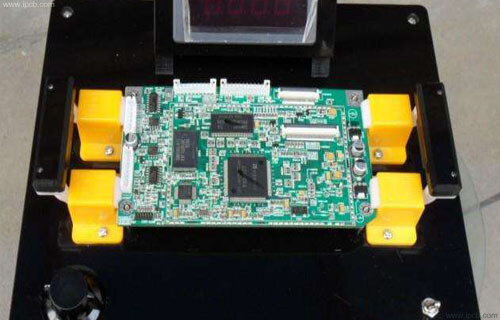In order to print the solder paste, the PCB assembly board without soldering can not fix the test end of thermocouple, so it is necessary to use the actual product to test.
In addition, the test sample can not be used repeatedly, more than 2 times. Generally speaking, as long as the test temperature does not exceed the limit temperature, the assembly board that has been tested once or twice can also be used as a formal product, but it is not allowed to use the same test sample repeatedly for a long time.
Because after long-term high-temperature welding, the color of printed circuit board will become dark, even become brown. Although the heating mode of hot blast stove is mainly convection conduction, there is also a small amount of radiation conduction. Dark brown PCB absorbs more heat than normal fresh light green PCB. Therefore, the measured temperature is higher than the actual temperature. If in lead-free welding, it is likely to cause cold welding.

PCB board temperature test
1, Selection of test points: according to the complexity of PCB assembly board and the channel number of collector (generally, the collector has 3-12 test channels), select at least three representative temperature test points that can reflect the high (hot spot), medium and low (cold point) of PCB surface assembly board.
The temperature (hot spot) is generally located in the middle of the furnace, where there are no components or where there are few and small components; the temperature (cold point) is generally located at the large-scale components (such as PLCC), large-area copper distribution, transmission guide rail or furnace hall edge, and the position where hot air convection can not reach.
2, Fixed thermocouple: use high-temperature solder (sn-90pb, solder with melting point over 289 degree Celsius) to weld the test ends of multiple thermocouples on the test point (solder joint), and the solder on the original solder joint must be removed before welding; Or use high-temperature adhesive tape to glue the test ends of thermocouple to each temperature test point of PCB. No matter which method is used to fix the thermocouple, it is required to ensure that the thermocouple is firmly welded, glued and clamped.
3, Insert the other end of the thermocouple into 1,2.3... Of the machine table. The position of the jack, or plug into the socket of the collector, pay attention to the polarity, do not plug in the reverse. Number the thermocouples and record the relative position of each thermocouple on the surface assembly plate.
4, Place the PCB assembly board of the tested surface on the conveyor chain / mesh belt at the entrance of reflow welder (if the collector is used, put the collector behind the surface PCB assembly board with a distance of more than 200 mm), and then start the KIC temperature curve test program.
5, With the operation of PCB, draw (display) the real-time curve on the screen (when the equipment comes with KIC test software).
6, When the PCB runs through the cooling zone, pull the thermocouple wire to pull the PCB assembly board back. At this time, a test process is completed, and the complete temperature curve and peak temperature / schedule are displayed on the screen (if the temperature curve collector is used, take out the PCB and collector from the outlet of reflow soldering furnace, and then read out the temperature curve and peak temperature schedule through software).